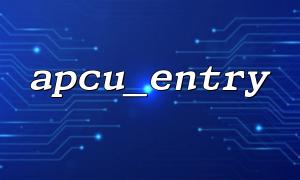Before we start implementing caching, we need to understand the basic concepts of APC (Alternative PHP Cache) and APCU (APC User Cache). APC is a PHP extension that can cache bytecode and user data, thereby improving the execution efficiency of PHP scripts. APCU is a subsequent version of APC, which is used only to cache user data and no longer cache bytecode.
In PHP, the APCU stores and retrieves data by providing a memory cache, which helps reduce the number of database queries, API calls, or compute-intensive operations, thereby increasing application response speed and reducing load.
apcu_entry is a function provided by APCU, which allows developers to efficiently check whether a data item already exists in the cache. If the data item does not exist, it calculates and caches the data item. Unlike apcu_fetch , apcu_entry not only checks the data in the cache, but also ensures that the cache creation and update process is atomic, so it is particularly suitable for handling concurrent requests.
The usage format of apcu_entry is as follows:
apcu_entry(string $key, callable $callback, int $ttl = 0): mixed
$key is the cached key (identifier).
$callback is a callback function that is called to generate data and cache it when the cache does not exist.
$ttl is the cached survival time (optional), the unit is seconds, the default is 0, indicating that it never expires.
The multi-layer caching mechanism is a technology that distributes data caches at multiple levels. Generally, we can divide the cache into the following layers:
Memory cache layer (such as APCU): stores short-term and frequently accessed data.
Database cache layer : stores long-term or infrequently changing data.
Persistent cache layer (such as Redis, Memcached): used to cache data storage at a large scale, suitable for cross-server applications.
Through this multi-tier caching mechanism, we can better utilize caches to improve application response speed while avoiding the limitations of single-tier caching.
The following is an example of a multi-layer cache implementation based on apcu_entry . This example first tries to get data from the APCU cache, if the data does not exist, it falls back to the database cache, and finally caches the result to the APCU.
// Try fromAPCUCache gets data
$data = apcu_entry('user_data', function() {
// ifAPCUNo data in the cache,Try from数据库缓存获取
$dataFromDB = getFromDatabaseCache('user_data');
if ($dataFromDB !== false) {
return $dataFromDB; // Database cache hit,Return data
}
// if数据库缓存也没有数据,Perform complex calculations orAPIask
$freshData = getFreshDataFromAPI();
// Cache new data to the database cache layer andAPCUCache layer
storeInDatabaseCache('user_data', $freshData);
return $freshData;
});
// Return data
echo json_encode($data);
// Example function to get database cache
function getFromDatabaseCache($key) {
// Assume that data is retrieved from the database cache
return false; // Return herefalseIndicates that there is no cache hit
}
// Sample functions stored in database cache
function storeInDatabaseCache($key, $data) {
// Suppose the data is stored in the database cache
}
In this example, apcu_entry first tries to get data from the APCU cache. If there is no cached data in the APCU, it falls back to the database cache, and eventually if the database cache also has no data, new data is generated through the callback function (such as getting data from the API) and cache it to the APCU and database cache.
In this way, we implement a multi-layer caching mechanism, which first responds to requests quickly through the APCU. If the APCU has no data, then obtains the data through slower database cache or API requests, and the data will be cached for subsequent requests.
Reduce database pressure : By storing data in the APCU cache, frequent database queries are reduced, thus reducing database burden.
Improve response speed : The cache hit data is read directly from memory, greatly improving access speed.
Resource saving : By using a multi-layer cache mechanism, the appropriate cache storage layer can be selected according to the frequency of data usage, avoiding the limitation of a single cache mechanism.
Cache failure : The effectiveness of the cache needs to be managed regularly to avoid access latency or data inconsistency caused by cache failure.
Concurrency problem : Although the apcu_entry function can ensure atomicity, in high concurrency situations, caching mechanisms still need to be carefully designed to ensure that there is no resource competition or cache penetration.
Memory management : APCU is a memory-based cache. When using it, you need to consider the memory limit of the server to avoid memory exhaustion.
By using the apcu_entry function to implement a multi-layer cache mechanism, the performance of PHP applications can be effectively improved, especially in high concurrency scenarios. By rationally designing cache policies, combining APCU and other cache layers, developers can achieve more efficient and stable web applications. For business scenarios that require quick response, optimization of the cache mechanism is undoubtedly the key to improving performance.















